Breadboard Layout for Lighthouse:
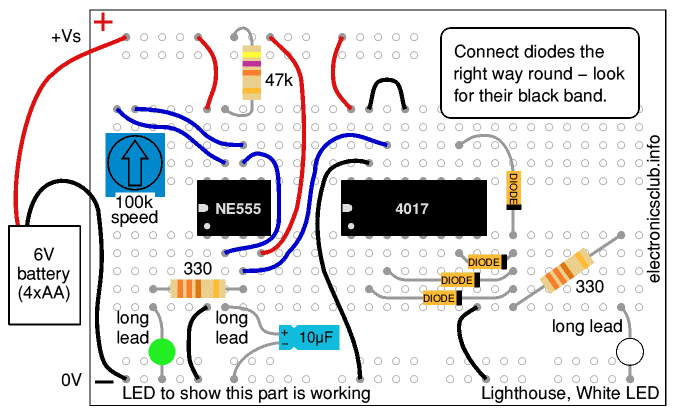
Circuit Diagram:
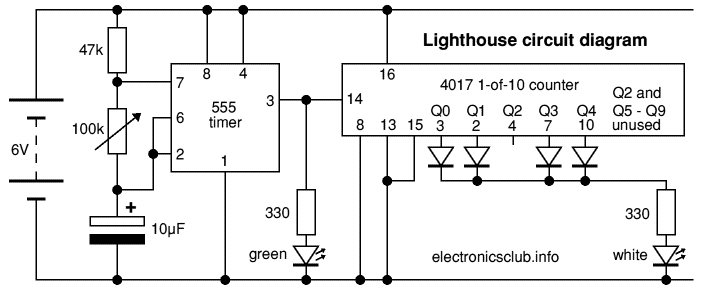

These projects introduce a 4017 1-of-10 counter and diodes to produce LED sequences.
Projects: Lighthouse | Traffic Light | Chaser Lights | parts
Also see: Breadboard | Circuit Diagrams | 555 Astable | 4017 counter
Next page: Breadboard Workshop 3
Remember to switch off (or disconnect) the battery before you start.
This circuit introduces diodes (connect the right way round, they have a black band at one end) and a second IC, a 4017 decade counter, to produce the lighthouse flash sequence.
The 555 timer section is very similar to the Alarm Box Light of Breadboard Workshop 1 but notice how a 1kΩ resistor is used to connect the variable resistor speed control to pin 6 of the 555 timer IC. This 1kΩ resistor ensures the pulses from the 555 timer are never too fast for the 4017 counter.
IC outputs must never be directly connected together but diodes can be used to combine outputs as here.


Build a similar project by soldering: Model Lighthouse on stripboard
Remember to switch off (or disconnect) the battery before you start.
If you are continuing after building the previous Lighthouse project you must remove the diodes, white LED and its resistor but leave the 4017 IC and its wire links on the breadboard.
The official UK traffic light colours are red, amber and green. Amber LEDs are difficult to obtain so it is generally best to use yellow as a substitute.

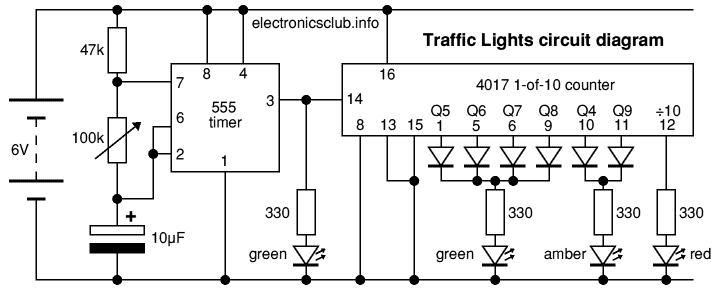
Build a similar project by soldering: Traffic Light on stripboard
Remember to switch off (or disconnect) the battery before you start.
If you are continuing after building the previous Traffic Lights project: remove the diodes, traffic light LEDs and their resistors. Also remove the black wire links to pins 13 and 15 of the 4017 IC, those pins have different connections in this project.
Building this project is quite difficult because space is limited and diodes have relatively short leads. It is best to add the diodes last and note that the diodes from 4017 pins 3 and 4 need to take a shorter route than shown, over the top of other diodes and resistors, so your finished circuit is unlikely look as neat as the picture!
Before you switch on: make sure that none of the diode and resistor leads are touching each other, this is often a problem on breadboards and it is wise to check before switching on any project.
Set the variable resistor 'speed control' to a middle value so you can see the lit LED 'chasing' from left to right and back again. Turn the control to increase the speed until the chasing looks smooth.
This is a challenging project to build with many diode and resistor leads on the right. You can make it a little easier by trimming the leads of the three 330Ω resistors to the right of the 4017 so they sit low on the board. Snipe-nose pliers can help bend leads and place them in tight spaces.
The blue wire link from pin 9 to pin 15 of the 4017 resets the counter to zero on the 9th step. This makes a 1-of-8 counter which is needed for the 8 steps in the chaser sequence.
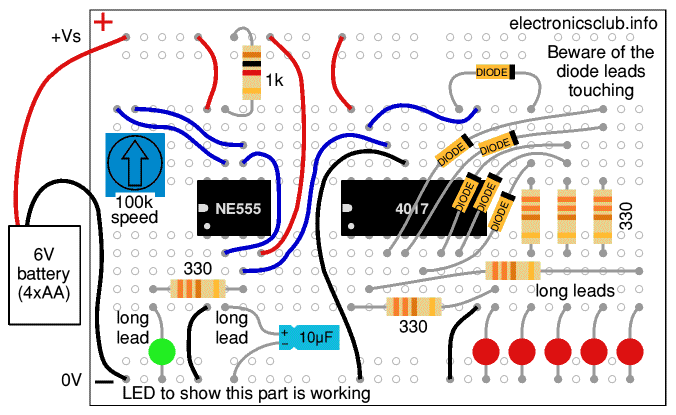
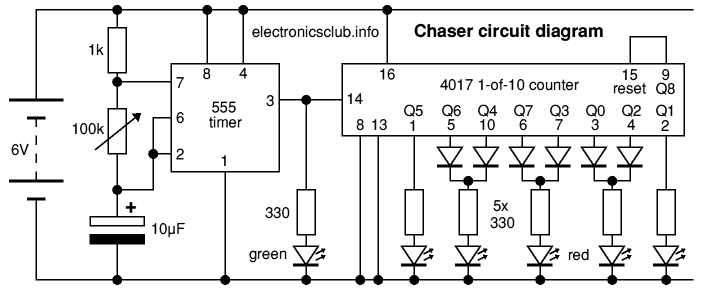
Use parts from Workshop 1 plus:
Change the 330Ω resistors for the LEDs to 470Ω. You will also need a battery clip.
If you ordered parts from Rapid for Workshop 1 you will already have enough extra resistors and red LEDs in the packs and will just need to order:
Most parts are supplied in packs but the extras are likely to be useful for other projects and it is good to have spares. Also see advice for building up a starter kit of parts.
Next page: Breadboard Workshop 3